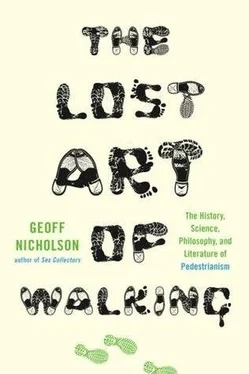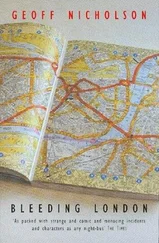FIRST DAY TEN MILES
SECOND DAY TWENTY MILES
THIRD DAY THIRTY MILES
FOURTH DAY FORTY MILES
FIFTH DAY FIFTY MILES
In a 2006 article and interview with Long in Art and Auction , the writer Roger Tatley admits to some skepticism about the ‘provenance of some of Long’s walks’, suggesting that maybe they didn’t really take place and were artistic inventions. He puts this to Long and describes the artist’s response as ‘gracious’.
‘My work’, says Long in the interview, ‘has to work on all levels, for unbelievers as well. It is of course possible that I don’t do any of these walks, and in some ways, if I didn’t, they would have to work on the level of true conceptual art, like Lawrence Weiner’s. He’s a great artist in that his use of language means it doesn’t matter whether the work exists or not. But the difference for me is that while ideas are important, it’s crucial that I do make my art — that these are real walks, real stones, real mud’.
When I walk through wild places, especially in the desert, I often see that people have been there before me and stamped out patterns on the earth or arranged stones or debris into shapes and designs, with greater or lesser degrees of skill and ingenuity, with apparently a greater knowledge of the conventions of art. The best of them look like fake Richard Longs, although of course there’s always the possibility that some of them may be real Richard Longs.
♦
One of Long’s earliest works, created in 1974, was a drawing and text piece called A Thousand Miles, a Thousand Hours . Perhaps Long is invoking Lao-tzu and his remark about the journey of a thousand miles, but if you’re at all familiar with the history of sustained eccentric walking, those words invoke a quite different character: Captain Barclay.
Captain Robert Barclay Allardice (1779–1854) was a Scot, a sportsman, an athlete, a soldier, a fan of horse racing, a gambler, a landowner, and a ‘gentleman’. Sometimes these roles sat uneasily together. For instance, one of the rules of the English class system decreed that as a gentleman he was allowed to ‘spar’ with professional boxers but he wasn’t allowed to ‘box’ against them. As a landowner he had no practical need to make money by performing athletic feats — he could have performed them as a gentleman amateur. However, he had the need to up the stakes and so bet heavily on himself. If he lost the bet, as he sometimes did, it could cost him the best part of a year’s income.
On the other hand, some of Barclay’s most impressive walking wasn’t done in competition or for money. Often it seems to have been done for the sheer hell of it. In 1802, for example, he set off on a journey from his home in Ury to walk to Kirkmichael and back again. He took the low road on the way out, then decided to return by the more difficult highland route, and even so clocked 180 miles in two and a half days. This could possibly be construed as part of a training regimen, but it surely also involved a considerable degree of showing off. Barclay had a reputation, undoubtedly well deserved but buffed by rumor and fantasy, like the story, certainly untrue, that he trained by carrying a load of butter and cheese on his back.
Barclay’s self-promotion paid off. History has remembered him as one of the very greatest walkers, or at least pedestrians. The two words were not quite synonymous in Barclay’s time. To be a pedestrian in the early nineteenth century simply meant that you raced on foot, as opposed to on horseback or in a carriage. ‘Go as you please’ races were popular, sometimes lasting several days, in which competitors were free to walk or run, or indeed hop, skip, and jump and certainly to rest, as and when they saw fit throughout the event. At the end the winner was simply the one who’d gone farthest around a predetermined route.
As a spectator sport, long pedestrian races must have been lacking in all sorts of ways: the competitors weren’t necessarily on the track at the same time, if they were they certainly weren’t likely to be on the same lap, and you might easily turn up to watch the event during a prolonged rest period and see nothing at all. But large crowds did gather at them, and large amounts of money were staked on the outcomes.
Young blades of the Regency period would bet on just about anything, so of course they bet on sporting events. But the rules of many sports were at that time unfixed. Every new contest was therefore an opportunity for invention, variation, and sometimes bizarrely complicated constraints to make the event, and the betting, that much more of a challenge.
Peter Radford, in his book The Celebrated Captain Barclay , recounts some gloriously eccentric pedestrian contests. One was devised by ‘an unnamed Duke’ who wagered a thousand guineas that he could find a man to walk the ten miles from Piccadilly to Hounslow within three hours, taking three steps forward and one step back. He wasn’t wagering on his own ability to do it, but on his ability to find a man who could, though Radford tells us the contest never actually took place.
Barclay first performed as a competitive pedestrian while still at school. At the age of seventeen he wagered that he could walk six miles ‘heel and toe’ (the standard definition of racewalking, with one part of one foot touching the ground at all times) on the Brixton to Croydon road within an hour. He succeeded, and won a hundred guineas, a good payday for anyone and a nice feat for a schoolboy, but not really so very impressive by Barclay’s later standards.
His career as a pedestrian began in earnest in 1801. The bet was that he could cover ninety miles in less than twenty-one and a half hours. The contest took place on the Roman Road at Barmby Moor in Yorkshire, and Barclay went back and forth on a one-mile stretch and completed the distance with over an hour to spare. Radford says:
‘He mostly walked but broke into an easy run each time he came to one of the slightly uphill sections.’
Barclay’s success in that event wasn’t completely unexpected. He’d been training fiercely and had done a trial at the nearby Newborough Priory, where he’d walked a hundred miles within eighteen hours through the toughest conditions. He walked in the rain, in the cold, in the dark, throughout the night. By daybreak he’d created an ankle-deep circular track in the mud. Richard Long would have loved it.
Barclay performed other impressive feats in this period. In 1803 he wagered that he could cover the sixty-four miles from his quarters in Porridge Island (an alleyway near St. Martin’s Church in central London) to Newmarket in Suffolk in twelve hours. He did it in ten, and this again must have been a pedestrian race rather than strictly a walking race, and some running or at least jogging must have been involved. In 1807 he challenged Abraham Wood, one of the best known competitive walkers of the day, to a twenty-four-hour race, the winner simply being the one who’d walked farthest in that time. Out of what can only have been sheer arrogance, Wood gave Barclay a twenty-mile head start, but then got into physical difficulties, resigned after six and a half hours, and subsequently died.
There was no shortage of other well-known pedestrians, such as a Lieutenant Halifax, who walked six hundred miles in twenty days at thirty miles a day, and then two hundred miles in one hundred hours. There was a pedestrian known as ‘Child, the miller of Wandsworth’, who walked forty-five miles in seven hours and fifty-seven minutes. Foster Powell, in 1790, for a bet of ‘20 guineas to 13’, wagered that he could walk from London to York and back in five days and eighteen hours — he did it with one hour and fifty minutes to spare. In 1808, a Mr. Downs walked four hundred miles in ten days, then thirty-five miles a day for twenty successive days.
Читать дальше












